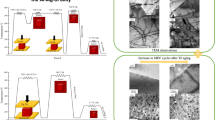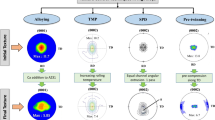Abstract
We studied the fatigue crack growth (FCG) characteristics of bulk nanotwinned Cu (NT-Cu) with different microstructural aspects such as grain size and twin thickness. We specifically addressed the crack closure, with particular emphasis on the intrinsic FCG resistances in the near-threshold regime. The results demonstrate that the NT-Cu samples have significantly improved fatigue resistances compared with conventional twin-free polycrystalline Cu, a fact we measured using the effective threshold stress intensity factor range, ΔKth,eff. This enhanced resistance can be traced back to the activation of a specific set of primary slip systems in the NT-Cu, known as special trans-twin dislocation, which dominates the crack-tip cyclic deformation, leading to a diminished level of cyclical slip irreversibility and, in turn, enhancing the inherent resistance to damage propagation.

摘要
本文研究了具有不同微观结构(如晶粒尺寸和孪晶厚度)的块体择优取向纳米孪晶Cu(NT-Cu)的疲劳裂纹扩展(FCG)特性, 着重讨论了裂纹闭合效应和近门槛值区域的本征FCG阻力. 与传统无孪晶的粗晶Cu相比, NT-Cu样品表现出显著提升的疲劳裂纹扩展抗力(有效门槛值应力强度因子范围, ΔKth,eff). 这种增强的裂纹扩展阻力与NT-Cu中特殊的跨孪晶位错滑移模式有关. 该位错主导着NT-Cu裂纹尖端的循环变形, 有效降低了裂纹尖端循环滑移不可逆水平, 从而提高了纳米孪晶材料损伤扩展的本征抗力.
Similar content being viewed by others
References
Suresh S. Fatigue of Materials (2nd edition). Cambridge: Cambridge University Press, 1998
Ritchie RO. Mechanisms of fatigue-crack propagation in ductile and brittle solids. Int J Fract, 1999, 100: 55–83
Hanlon T, Tabachnikova E, Suresh S. Fatigue behavior of nanocrystalline metals and alloys. Int J Fatigue, 2005, 27: 1147–1158
Lu L, Chen X, Huang X, et al. Revealing the maximum strength in nanotwinned copper. Science, 2009, 323: 607–610
Shen YF, Lu L, Lu QH, et al. Tensile properties of copper with nanoscale twins. Scripta Mater, 2005, 52: 989–994
Li X, Wei Y, Lu L, et al. Dislocation nucleation governed softening and maximum strength in nano-twinned metals. Nature, 2010, 464: 877–880
Zhao H, Li Z, Gao H, et al. Fracture and toughening mechanisms in nanotwinned and nanolayered materials. MRS Bull, 2022, 47: 839–847
Lu L, Zhao HZ. Progress in strengthening and toughening mechanisms of heterogeneous nanostructured metals. Acta Metall Sin, 2022, 58: 1360–1370
Kim SW, Li X, Gao H, et al. In situ observations of crack arrest and bridging by nanoscale twins in copper thin films. Acta Mater, 2012, 60: 2959–2972
Liu L, Wang J, Gong SK, et al. Atomistic observation of a crack tip approaching coherent twin boundaries. Sci Rep, 2014, 4: 4397
Shan ZW, Lu L, Minor AM, et al. The effect of twin plane spacing on the deformation of copper containing a high density of growth twins. JOM, 2008, 60: 71–74
Luo S, You Z, Lu L. Thickness effect on fracture behavior of columnar-grained Cu with preferentially oriented nanoscale twins. J Mater Res, 2017, 32: 4554–4562
You Z, Qu S, Luo S, et al. Fracture toughness evaluation of nanostructured metals via a contactless crack opening displacement gauge. Materialia, 2019, 7: 100430
Zhao HZ, You ZS, Tao NR, et al. Anisotropic toughening of nanotwin bundles in the heterogeneous nanostructured Cu. Acta Mater, 2022, 228: 117748
Singh A, Tang L, Dao M, et al. Fracture toughness and fatigue crack growth characteristics of nanotwinned copper. Acta Mater, 2011, 59: 2437–2446
Alkan S, Chowdhury P, Sehitoglu H, et al. Role of nanotwins on fatigue crack growth resistance—Experiments and theory. Int J Fatigue, 2016, 84: 28–39
Sangid MD, Pataky GJ, Sehitoglu H, et al. Superior fatigue crack growth resistance, irreversibility, and fatigue crack growth–microstructure relationship of nanocrystalline alloys. Acta Mater, 2011, 59: 7340–7355
Ritchie RO. Mechanisms of fatigue crack propagation in metals, ceramics and composites: Role of crack tip shielding. Mater Sci Eng-A, 1988, 103: 15–28
Gan D, Weertman J. Crack closure and crack propagation rates in 7050 aluminum. Eng Fract Mech, 1981, 15: 87–106
Cheng Z, Zhou H, Lu Q, et al. Extra strengthening and work hardening in gradient nanotwinned metals. Science, 2018, 362: eaau1925
Standard Test Method for Measurement of Fatigue Crack Growth Rates. American Society of Testing and Materials, 2015
Rackwitz J, Yu Q, Yang Y, et al. Effects of cryogenic temperature and grain size on fatigue-crack propagation in the medium-entropy CrCoNi alloy. Acta Mater, 2020, 200: 351–365
You ZS, Lu L, Lu K. Tensile behavior of columnar grained Cu with preferentially oriented nanoscale twins. Acta Mater, 2011, 59: 6927–6937
Paris P, Erdogan F. A critical analysis of crack propagation laws. J Basic Eng, 1963, 85: 528–533
Pippan R, Hohenwarter A. Fatigue crack closure: A review of the physical phenomena. Fatigue Fract Engng Mater Struct, 2017, 40: 471–495
Suresh S, Ritchie RO. A geometric model for fatigue crack closure induced by fracture surface roughness. Metall Trans A, 1982, 13: 1627–1631
Riemelmoser FO, Pippan R. Crack closure: A concept of fatigue crack growth under examination. Fatigue Fract Eng Mater Struct, 1997, 20: 1529–1540
Wolf E. Fatigue crack closure under cyclic tension. Eng Fract Mech, 1970, 2: 37–45
Liaw PK, Leax TR, Williams RS, et al. Near-threshold fatigue crack growth behavior in copper. Metall Trans A, 1982, 13: 1607–1618
Chowdhury PB, Sehitoglu H, Rateick RG. Predicting fatigue resistance of nano-twinned materials: Part II—Effective threshold stress intensity factor range. Int J Fatigue, 2014, 68: 292–301
Pippan R. Dislocation emission and fatigue crack growth threshold. Acta Metall Mater, 1991, 39: 255–262
Pippan R. The condition for the cyclic plastic deformation of the crack tip: The influence of dislocation obstacles. Int J Fract, 1992, 58: 305–318
Mughrabi H. Cyclic slip irreversibility and fatigue life: A microstructure-based analysis. Acta Mater, 2013, 61: 1197–1203
Chowdhury PB, Sehitoglu H, Rateick RG. Predicting fatigue resistance of nano-twinned materials: Part I—Role of cyclic slip irreversibility and Peierls stress. Int J Fatigue, 2014, 68: 277–291
You Z, Li X, Gui L, et al. Plastic anisotropy and associated deformation mechanisms in nanotwinned metals. Acta Mater, 2013, 61: 217–227
Bu L, Cheng Z, Zhang Y, et al. Trans-twin dislocations in nanotwinned metals. Scripta Mater, 2023, 229: 115348
Pan Q, Zhou H, Lu Q, et al. History-independent cyclic response of nanotwinned metals. Nature, 2017, 551: 214–217
Chowdhury PB, Sehitoglu H, Rateick RG, et al. Modeling fatigue crack growth resistance of nanocrystalline alloys. Acta Mater, 2013, 61: 2531–2547
Acknowledgements
Lu L acknowledges the financial support by the National Natural Science Foundation of China (NSFC, 51931010 and 92163202) and the Key Research Program of Frontier Science and International partnership program (GJHZ2029).
Author information
Authors and Affiliations
Contributions
Author contributions Lu L designed and supervised the project; Zhao R and Zhao H performed the experiments. All authors analyzed the data, discussed the results and wrote the paper.
Corresponding author
Ethics declarations
Conflict of interest The authors declare that they have no conflict of interest.
Additional information
Ruike Zhao is currently a PhD student under the supervision of Professor Lei Lu at the Institute of Metal Research, Chinese Academy of Sciences (CAS), China. He received his Bachelor degree from Northeastern University, China, in 2019.
Huaizhi Zhao received his PhD degree in materials physics and chemistry from the University of Science and Technology of China in 2022. He is currently a research scientist at the Institute of Fluid Physics, China Academy of Engineering Physics. His research focuses on the deformation and fracture behavior of bulk nanostructured metallic materials.
Lei Lu is a distinguished professor at Shenyang National Laboratory for Materials Science at Institute of Metal Research, CAS, China. Her research interests include the synthesis, microstructure design and characterization, plastic deformation, and mechanisms of heterogeneous nanostructured metallic materials. She is an editor for Acta Materialia and Scripta Materialia, and an associate editor for Science China Materials.
Rights and permissions
About this article
Cite this article
Zhao, R., Zhao, H. & Lu, L. Superior fatigue crack growth resistance in bulk Cu with highly oriented nanotwins. Sci. China Mater. 66, 4251–4257 (2023). https://doi.org/10.1007/s40843-023-2622-1
Received:
Accepted:
Published:
Issue Date:
DOI: https://doi.org/10.1007/s40843-023-2622-1




